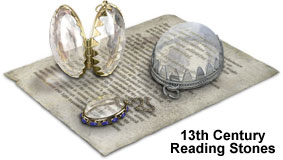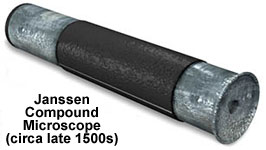
|
1000-1599
During the early years of the second millennium, Arabic science proliferated, especially with regards to research in astronomy, optics, and vision. The Chinese investigations of optics also flourished for a time as they experimented with lenses, mirrors, and shadows, but stagnated after the 1200s.

In medieval Europe, scholars strictly adhered to the teachings of the ancient Greek philosophers, particularly Aristotle, as well as those of the Church. Science was viewed as a process that required only observation of the natural world interpreted by rational thought and correct theology. Experimentation was not considered essential to understanding how the world works, at least not a world thought to lie at the center of a changeless universe.
Nevertheless, this 600-year period did see significant breakthroughs in optics and science. The Greek notion that the eyes transmit light rays was finally discarded and the eyes were correctly understood to be light receivers. The first truly functional magnifying lenses were produced in the 1200s, and by the 1400s lenses were being used to make reading glasses. The Chinese had developed eyeglasses with colored lenses even earlier, but these apparently were used for ornamental purposes, rather than vision correction. By 1600, high quality lenses were being produced and used to make the first microscopes and telescopes.
During the second half of the 1200s, as the Arab and Chinese sciences were fading, Europe began to emerge from its Dark Age. Robert Grosseteste, an English bishop (Bishop of Lincoln) and scholar, introduced Latin translations of Greek and Arabic philosophical and scientific writings to medieval Europe. Remarkably, he proposed that a theory could only be validated by testing its predictions with experimentation--a substantial deviation from Aristotelian philosophy and the beginning of scientific method in Europe. His student, Roger Bacon, continued his advocacy of experimentation and tried, unsuccessfully, to get the Church to incorporate experimental methods into its educational system.

The 1400s and 1500s saw the beginning of the end for the Ptolemaic worldview, which regarded the Earth as the center of universe with the sun, stars, and planets revolving around it. Scientists were making their own observations of the world and some, like Nicolas Copernicus, began to believe that the Ptolemaic theory couldn't explain their observations. The year he died, 1543, Copernicus published a collection of writings explaining his heliocentric theory that placed the Earth and other planets in orbit around the sun. This launched the Scientific, or Copernican, Revolution, but it would take 150 years before this new worldview would be completely accepted.
In 1572, astronomer Tycho Brahe observed a supernova in the constellation Cassiopeia. Seeing a "new star" suddenly appear in the sky, intensify in brightness, then fade from view over the next 18 months, intrigued but unsettled the astronomer. He and others began to question the Aristotelian notion of a perfect and unchanging universe.
| 1000 to 1599 |
| 1000-1199 |
Iranian Islamic philosopher and physician Ibn Sina (Latin name Avicenna) theorizes that if the perception of light is due to the emission of particles by a luminous source, then the speed of light must be finite.
Spanish-Arab Islamic philosopher, jurist, and physician, Ibn Rushd (Latin name Averroës), writes books on diverse topics, from astronomy to religion, integrating Islamic traditions with ancient Greek thought. For centuries, his summaries and commentaries on Aristotle's works and on Plato's Republic will strongly influence both the Islamic world and Europe.
Chinese philosopher Shen Kua writes Meng ch'i pi t'an (Dream Pool Essays), where he discusses concave mirrors and focal points. He notes that images reflected in a concave mirror are inverted, and describes the camera obscura effect. He is also said to have constructed a celestial sphere and a bronze sundial.
|
| 1200-1250 |
Robert Grosseteste, an English bishop (Bishop of Lincoln) and scholar, introduces Latin translations of Greek and Arabic philosophical and scientific writings to medieval Europe. He pursues studies in geometry, optics and astronomy, experimenting with mirrors and lenses, producing a crude but functional magnifying lens. He proposes that a theory can only be validated by testing its consequences with experimentation, a remarkable deviation from Aristotelian philosophy and the beginning of scientific method in the Western world. In his writings on astronomy, he claims that the Milky Way was the fusion of light from many small, close stars.
Chinese scholars Chiang Khuei and Fang Chheng mention the interaction between movement and illumination in their poetic book Meng Liang Lu, but Chinese interest in optics and the physics of light and color diminishes over the next three hundred years. |
1268-1272
|
Roger Bacon, an English philosopher and student of Robert Grosseteste, writes several books about his experiments. In Opus Maius, Bacon reviews knowledge of the period concerning the magnification of objects using convex lenses. Several other treatises, including De Multiplicatione Specierum and Perspectiva, review the principle of the camera obscura, but do not describe the apparatus he used in experiments. Bacon is the first to theorize that lenses may have applications in the correction of eyesight, and he is also the first to apply geometry to the study of optics. Bacon postulates, but cannot demonstrate, that the colors of a rainbow are due to the reflection and refraction of sunlight through individual raindrops. |
| 1270 |
Witelo of Silesia (Latin name Vitellio), a Polish physicist, completes a volume entitled Perspectiva (at the time, the science of optics was called "perspectives"). This would become the most important medieval treatise on optics and the standard text on the subject until the seventeenth century. |
| 1275 |
The English Dominican scholar Albertus Magnus (later St. Albertus Magnus, the patron saint of the natural sciences) studies the rainbow effect of light and speculates that the velocity of light is extremely fast, but finite. He also examines the darkening action of bright sunlight on crystals of silver nitrate. |
| 1303 |
Bernard of Gordon, a French physician, writes in a volume of his medical series Lilium Medicinae about the use of spectacles as a means of correcting far-sightedness--the first written record of lenses being used to correct vision. |
| 1304 |
Theodoric of Freiberg (Germany), a Dominican monk, demonstrates that a rainbow is caused by internal refraction and reflection of sunlight within individual raindrops, proving Roger Bacon's theory and disproving Aristotle's supposition that it arises from an entire cloud. Unlike many scholars of his time, he observes and accounts for the secondary rainbow as well as the primary rainbow. |
| 1440 |
Decades before Copernicus, Nicholas of Cusa (Germany) speculates in De docta ignorantia (On Learned Ignorance) that the Earth is not the center of the universe and is one of countless heavenly bodies occupying the cosmos. These speculations will continue throughout subsequent writings. |
| 1472 |
Johannes Regiomontanus (Germany) makes the first recorded observation of Halley's comet. |
| 1480 |
Leonardo da Vinci (Italy) studies the reflection of light and compares it to the reflection of sound waves. |
| 1520 |
Franciscus Maurolycus,a Jesuit priest, astronomer and mathematician, writes De Subtilitate, in which he discusses theories on light, theaters, and light theaters. In 1521, he finishes Theoremata De Lumine Et Umbra Ad Perspectivam, an explanation about how to build a microscope. Maurolycus also observes that in a pinhole camera, an object's shadow moves in the opposite direction from the object and he observes solar eclipses with a camera obscura. |
| 1521 |
In his translation of Vitruvius's Treatise On Architecture, Caesare Caesariano (Italy) describes an experiment with a camera obscura, said to have been performed by Papnutio--a Benedictine monk. In this experiment, a cone-shaped tube in a wall was used to image objects outside a room. Caesariano is a student of da Vinci. |
| 1543 |
Nicolaus Copernicus (Poland) publishes the final version of his heliocentric theory, De revolutionibus orbium coelestium libri vi (Six Books Concerning the Revolutions of the Heavenly Orbs). |
| 1545 |
Reinerus Gemma-Frisius (Holland) publishes De Radio Astronomica Et Geometrico, which includes both a description and drawing of the 1544 solar eclipse he observed in Louvain on January 24. |
| 1550 |
Girolamo Cardano (Italy), a mathematician and physician, publishes De Subtilitate Libri in which he describes a camera obscura with a convex lens in the aperture. Cardano also publishes a detailed description of improved images from his configuration. |
| 1551 |
Erasmus Reinhold, a German mathematician and astronomer, reports using a pinhole camera to observe solar eclipses and describes in detail how the camera is used. He also mentions observing his surroundings with the pinhole camera. |
| 1556 |
Alchemist Georg Fabricius publishes a book about his experiments with metals, noting that by adding a solution of salt and silver nitrate to certain ores, the metal would turn from white in the prepared state to black when exposed to sunlight. |
| 1558 |
In 1558, Giovanni Battista Della Porta, (Italy) publishes Magiae Naturalis Libri (Natural Magic), a reference containing detailed information about a number of sciences including physics, astronomy, and alchemy. He also mentions several details about the camera obscura. In a later work, he compares the human eye to the camera and refers to vision in terms of refraction, prisms, lenses, and discusses optics in general. |
| 1568 |
Daniel Barbaro (Italy) publishes La Practica Della Perspectiva, describing the use of a bi-convex lens to enhance images in a camera obscura. He points out that the sharpened image can now be outlined with a pencil and suggests the method for use by artists and painters. |
| 1572 |
Danish Atronomer Tycho Brahe witnesses the sudden appearance of a "new star" (a supernova) and proposes the groundbreaking theory that the universe is in a constant state of change. |
| 1572 |
Freidrich Risner (Germany) translates works on optics by Alhazen and Witelo into a Latin edition that made the concepts and findings of these scholars accessible to the growing European community of scientists. |
| 1584 |
Giordano Bruno, an Italian philosopher and scholar, writes On the Infinite Universe and Worlds, rejecting the Aristotelian view of an Earth-centered universe and theorizing that the universe is infinite with an infinite number of worlds. He is burned at the stake in 1600 for refusing to recant his views. |
| 1589 |
Abandoning the accepted thinking of the times, Italian physicist and astronomer Galileo Galilei proposes theories of motion that contradict those of Aristotle. He records his theories and experimental results in De motu (On Motion). |
| 1585 |
Giovanni Benedetti, an Italian mathematician, writes Diversarum Speculationum Mathematicarum, and describes the use of concave mirrors and convex lenses to correct images. |
| 1590 |
Dutch lens maker Zacharias Janssen and his father, Hans, invent the first compound microscope. The device is made using a convex objective and concave eyepiece. |
| 1596 |
David Fabricius (Holland) makes the first recorded observation of a variable star, Mira Ceti (also called Omicron Ceti) but mistakes it for a nova when it fades from view. |
|
|
 |
 |
 |
BACK TO TIMELINE IN OPTICS HOME
Questions or comments? Send us an email.
© 1995-2025 by
Michael W. Davidson
and The Florida State University.
All Rights Reserved. No images, graphics, software, scripts, or applets may be reproduced or used in any manner without permission from the copyright holders. Use of this website means you agree to all of the Legal Terms and Conditions set forth by the owners.
This website is maintained by our
Graphics & Web Programming Team
in collaboration with Optical Microscopy at the
National High Magnetic Field Laboratory.
Last Modification Friday, Nov 13, 2015 at 01:18 PM
Access Count Since August 1, 2000: 72869
Visit the websites of our partners in education:
|


